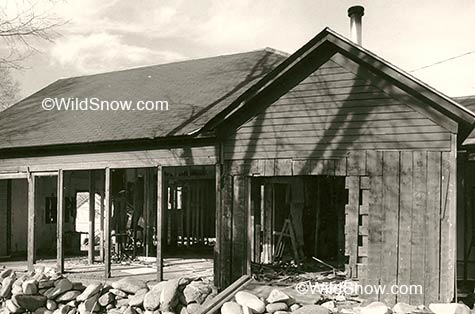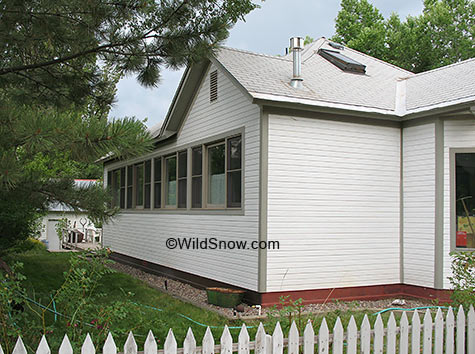We live in a 100+ year old house in Carbondale, Colorado. The famed WildSnow workshop is in the detached garage, as is my office. By some standards, when we bought the house we did a historic restoration — mainly because we chose to keep nearly the original footprint and using a historic traditional look with our siding and windows. During our renovation we renewed and replaced nearly 100% of the house, including removing and rebuilding all the walls, having the house lifted for a new foundation, and doing all new mechanicals, wiring and plumbing. Basically, we built a new home by taking almost every chunk of the old home out in sequence and replacing with new.

WildSnow World HQ in 1989.

Restored.
Original essay:
In many affluent resort towns, historic preservation and restoration are nearly as hip as owning a Prius. Only problem is you’ve still got a choice about what vehicle you buy, but in ski town bergs such as Aspen, when it comes to the historic value of your property the nanny-state is there to do your thinking for you. Yippee.
In Aspen this summer of 2007, despite considerable citizen opposition, the city council (who as far as I know have a virtual non-extant education in historical preservation) approved an ordinance to prevent demolition, major alteration or restoration of any building thirty years old or more. In a nutshell, the new rules set up a process that requires any property owner in the city who applies for a demolition permit, or a building permit, must submit to a review by the community development director to determine if the building has “historic merit.”
If the building is ruled to have a hippy era vibe, or perhaps something more significant (perhaps actually history having to do with skiing?), the property will then go through a historic designation review and, if designated, be subject to the city’s historic preservation laws. The rules are are onerous and restrictive enough to actually limit your property value because of the difficulty in improving or remodeling. Like I said: Historic preservation, yippee! More here.
(In reality, much of Aspens new rules involve a backdoor way of halting construction and growth, but that part of the issue is not germane to this discussion, other than the inherent dishonesty in that which devalues the whole concept of the government being involved in historic preservation.)
In terms of politics, the historic preservation debate comes down to this question: Should the greater community work in partnership with private property owners and allow them the freedom to preserve or destroy the historic character of their possession, or do the rights of the community to view antique buildings from the street trump private property rights? More, if your mortgage isn’t even paid off yet, can a home you built or remodeled 30 years ago be essentially taken over by government bureaucrats who may not have any more expertise in architectural appreciation than you do?
So, welcome to the nanny state of Aspen, where as soon as your home turns thirty years old, your neck is on the chopping block in terms of the city dictating to the nth degree what you can and cannot do in terms of remodeling, improvements, or demolition and rebuild.
I’ve got quite a bit of experience in the nuts and bolts of historic preservation. For years as a builder I worked on restoration of numerous old mining town slash ski town buildings, including being the general contractor on a funded restoration project in Crested Butte. More, when we moved to Carbondale, Colorado seventeen years ago we bought a century old home and did a 100% restoration, both out of appreciation of the classic lines and floorplan, but also for pragmatic reasons — mostly to retain a non-standard building envelope setback that would have required a zoning variance if we’d scraped and re-built.
For a time I was proud of our project, but now I regret it to some degree. Since Carbondale tends to be an Aspen wannabe in terms of bigger government and nanny state-ism, I’m feeling like I’ve opened myself up to some ‘crat my taxes hired telling me what to do with my own property. It rubs me the wrong way, in fact, it’s just plain wrong. I wish we’d scraped our house and built new, so I didn’t have to worry.
What’s historic, anyway? At least in terms of buildings, there are indeed certain architectural masterpieces that the greater public has a right to experience for generations, but the average home, or smaller less interesting building, are simply not worthy of compromising private property values for preservation. Indeed, I’d imagine that one of the things taught in college historical preservation programs is what’s worth restoring and what is not. After all, everything old is in some sense “historic.”
Of course, once this is in the government’s hands they’ll err on the side of caution. They’ll no doubt designate anything as “historic” if they have the slightest inclination to do so. As proof, just look at Aspen’s 30-year ordinance. To think any building 30 years old could even be called “historic” is patently ridiculous. Indeed, the whole thing reeks.
Look at the big picture. A big part of the beauty of the urban environment is the flux of change. More, what we have now and perhaps feel like preserving is nothing less than a product of that flux. Stop the process, and you sterilize the local culture. From the outside it’ll look cute and you’ll be able to ID the bar where you bought your first “cigarette” thirty years ago. But the reason why you sat in the bar back then was the energy of flux and change that made Carbondale or Aspen such fun dynamic places. That energy was not created by the government. Far far from it…
In the end, there are indeed places and structures that have historic significance. With education and solid cultural values, such places will be preserved with a mix of government intrusion and well meaning acts on the part of property owners. As we did. But overregulate, and owners will do anything they can to prevent “historic designation” because it involves no economic gain, and no added peace of mind; it will involve only worry about a controlling government doing things that may compromise your hard won economic well being.
In other words, over-regulate historic preservation as Aspen has done, and you’ll end up with few or no truly historic structures. When everything is “historic,” nothing is “historic.” And eventually, nothing is hip.
While I did most of the work myself, during the 12 months the renovation took I hired a number of helpers. It would have been nice if these individuals would have had more training in building restoration. With heavy supervision and hands-on work from myself, it all came together. Took about a year.
Another interesting thing about being involved in renovation is that politics and government may intrude. This has happened up in Aspen, and we suspect historic preservation may become an issue down here in Carbondale — or it already is.
WildSnow.com publisher emeritus and founder Lou (Louis Dawson) has a 50+ years career in climbing, backcountry skiing and ski mountaineering. He was the first person in history to ski down all 54 Colorado 14,000-foot peaks, has authored numerous books about about backcountry skiing, and has skied from the summit of Denali in Alaska, North America’s highest mountain.
